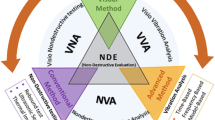Abstract
We analyze the peculiarities of power function in the description of fatigue curve. The interrelation between fatigue curves constructed by conjugate regressions is shown. Formulas are presented for the determination of parameters of the equation of fatigue curve from average values of fatigue life at given stresses.
Similar content being viewed by others
References
GOST 25.504-82. Strength Design and Test. Methods for the Calculation of Fatigue Resistance Characteristics [in Russian], Izd-vo Standartov, Moscow (1982).
V. P. Kogaev, N. A. Makhutov, and A. P. Gusenkov, Strength Design and Life Prediction of Machinery Parts and Structures. A Handbook [in Russian], Mashinostroenie, Moscow (1985).
International Standard. ISO 12107:2003. Metallic Materials. Fatigue Testing. Statistical Planning and Analysis of Data (2003).
GOST 25.502-79. Methods for the Mechanical Testing of Metals. Fatigue Test Methods [in Russian], Izd-vo Standartov, Moscow (1979).
V. T. Troshchenko and L. A. Sosnovskii, Fatigue Resistance of Metals and Alloys. A Handbook [in Russian], Part 1, Naukova Dumka, Kiev (1987).
M. N. Stepnov, Statistical Methods for the Processing of Mechanical Test Data. A Handbook [in Russian], Mashinostroenie, Moscow (1985).
L. Zaks, Statistical Estimation [Russian translation], Statistika, Moscow (1976).
L. Z. Rumshiskii, Mathematical Treatment of Experimental Results. A Handbook [in Russian], Nauka, Moscow (1971).
N. V. Smirnov and I. V. Dunin-Barkovskii, Short Course of Mathematical Statistics for Technical Applications [in Russian], Fizmatgiz, Moscow (1959).
S. V. Serensen (Ed.), V. P. Kogaev, and R. M. Shneiderovich, Load-Carrying Ability and Strength Design of Machinery Parts. A Handbook [in Russian], 3rd Revised and Enlarged Edition, Mashinostroenie, Moscow (1975).
V. V. Nalimov, Application of Mathematical Statistics to the Analysis of Matter [in Russian], Fizmatgiz, Moscow (1960).
DSTU 2444-94. Strength Design and Test. Fatigue Resistance. Terms and Definition [in Ukrainian], Valid from 1 July 1995.
Author information
Authors and Affiliations
Additional information
__________
Translated from Problemy Prochnosti, No. 3, pp. 147–155, May–June, 2007.
Rights and permissions
About this article
Cite this article
Shul’ginov, B.S., Kolomiets, A.P. On the utilization of power function for the description of fatigue test results. Strength Mater 39, 331–337 (2007). https://doi.org/10.1007/s11223-007-0037-x
Received:
Issue Date:
DOI: https://doi.org/10.1007/s11223-007-0037-x




